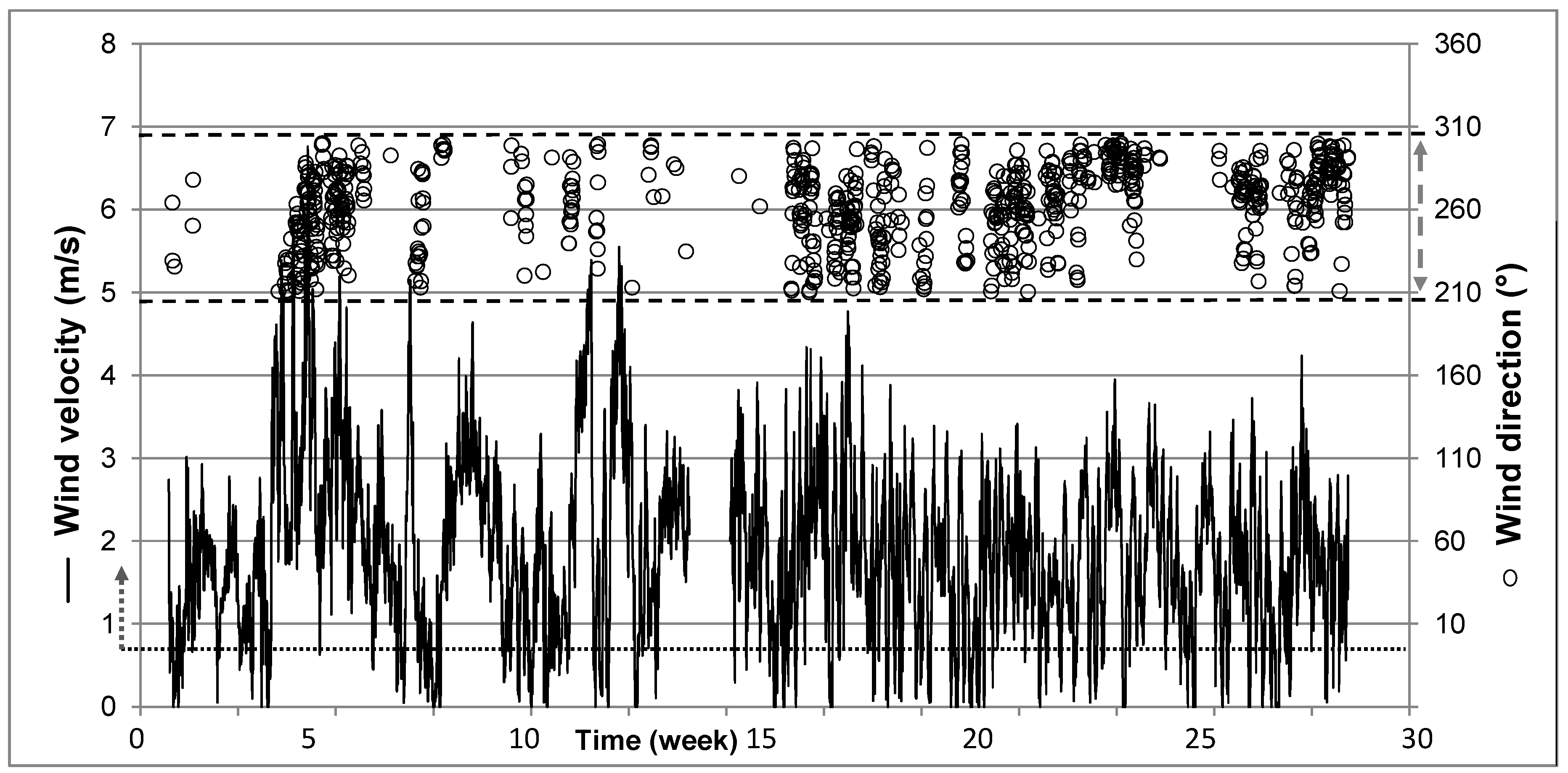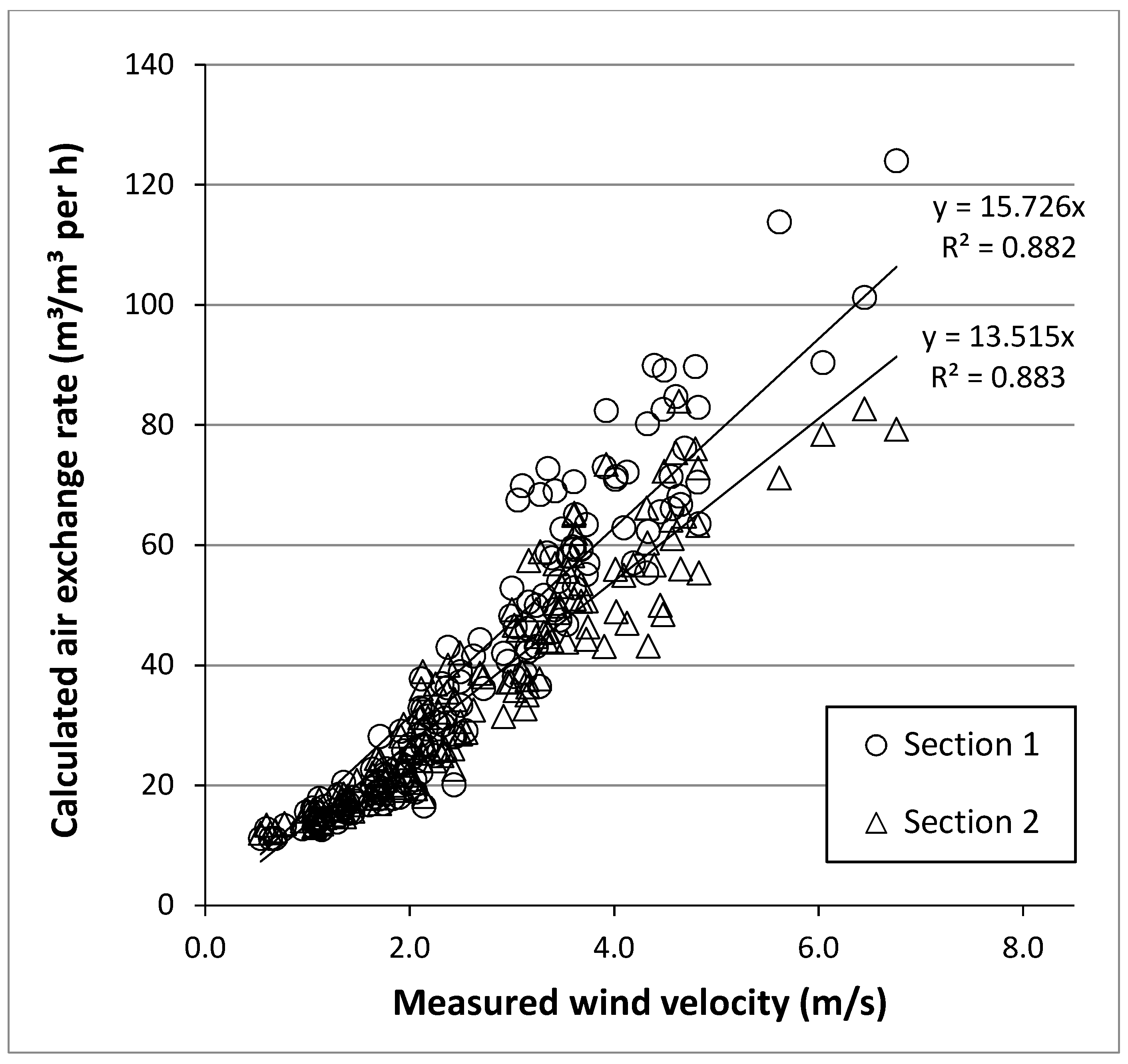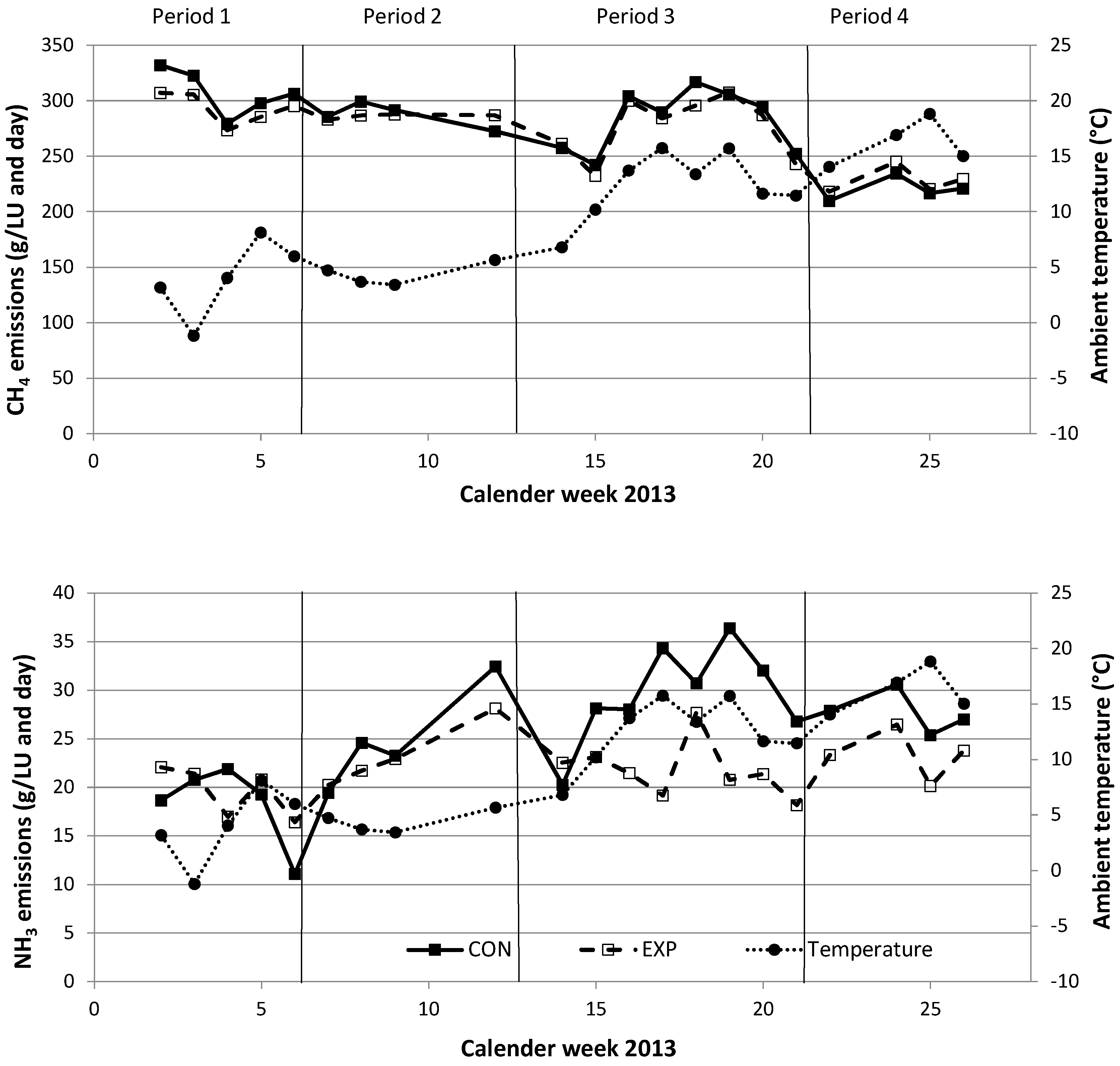Quantification of Methane and Ammonia Emissions in a Naturally Ventilated Barn by Using Defined Criteria to Calculate Emission Rates
Abstract
:Simple Summary
Abstract
1. Introduction
2. Materials and Methods
2.1. Experimental Building and Measurement Technique
2.2. Measurement Concept
2.3. Animals and Feeding
2.4. Data Presentation
3. Results
3.1. Methodical Consideration
3.2. Calculation of the Ventilation Rate
3.3. Effect of Weather Conditions
3.4. Methane and Ammonia Emission Rates Related to Floor Section and Feeding Periods
4. Discussion
4.1. Methodical Considerations and Calculation of the Ventilation Rate
4.2. Effect of Weather Conditions
4.3. Methane and Ammonia Emission Rates Related to Floor Section and Feeding Periods
5. Conclusions
Author Contributions
Acknowledgments
Conflicts of Interest
References
- FAO. Livestock’s Long Shadow—Environmental Issues and Options; Food and Agriculture Organization of the United Nations: Rome, Italy, 2006; Available online: http://www.fao.org/docrep/010/a0701e/a0701e00.HTM (accessed on 18 January 2018).
- Owen, J.J.; Silver, W.S. Greenhouse gas emissions from dairy manure management: A review of field-based studies. Glob. Chang. Biol. 2015, 21, 550–565. [Google Scholar] [CrossRef] [PubMed]
- European Economic Area (EEA). European Union Emission Inventory Report 1990–2013 under the UNECE Convention on Long-Range Transboundary Air Pollution 2015; EEA Technical Report No. 8/2015; European Economic Area (EEA): København, Denmark, 2015. [Google Scholar]
- Wu, W.; Zhang, G.; Kai, P. Ammonia and methane emissions from two naturally ventilated dairy cattle buildings and the influence of climatic factors on ammonia emissions. Atmos. Environ. 2012, 61, 232–243. [Google Scholar] [CrossRef]
- Ngwabie, N.M.; Vanderzaag, A.; Jayasundara, S.; Wagner-Riddle, C. Measurements of emission factors from a naturally ventilated commercial barn for dairy cows in a cold climate. Biosyst. Eng. 2014, 127, 103–114. [Google Scholar] [CrossRef]
- Cortus, E.L.; Jacobson, L.D.; Hetchler, B.P.; Heber, A.J.; Bogan, B.W. Methane and nitrous oxide analyzer comparison and emissions from dairy freestall barns with manure flushing and scraping. Atmos. Environ. 2015, 100, 57–65. [Google Scholar] [CrossRef]
- Joo, H.S.; Ndegwa, P.M.; Heber, A.J.; Ni, J.-Q.; Bogan, B.W.; Rmirez-Dorronsoro, J.C.; Cortus, E. Greenhouse gas emissions from naturally ventilated freestall dairy barns. Atmos. Environ. 2015, 102, 384–392. [Google Scholar] [CrossRef]
- Samer, M.; Loebsin, C.; Fiedler, M.; Ammon, C.; Berg, W.; Sanftleben, P.; Brunsch, R. Heat balance and tracer gas technique for airflow rates measurement and gaseous emissions quantification in naturally ventilated livestock buildings. Energy Build. 2011, 43, 3718–3728. [Google Scholar] [CrossRef]
- Storm, I.M.L.D.; Hellwing, A.L.F.; Nielsen, A.I.; Madsen, J. Methods for measuring and estimating methane emission from ruminants. Animals 2012, 2, 160–183. [Google Scholar] [CrossRef] [PubMed]
- Intergovernmental Panel on Climate Change (IPCC). IPCC Guidelines for National Greenhouse Gas Inventories. In National Greenhouse Gas Inventories Program; Eggleston, H.S., Buendia, L., Miwa, K., Ngara, T., Tanabe, K., Eds.; Institute for Global Environmental Strategies (IGES): Hayama, Kanagawa, Japan, 2006; Available online: http://www.ipcc-nggip.iges.or.jp/public/2006gl/pdf/4_Volume4/V4_10_Ch10_Livestock.pdf (accessed on 18 January 2018).
- Hill, J.; McSweeney, C.; Wright, A.D.G.; Bishop-Hurley, G.; Kalantar-Zadeh, K. Measuring methane production from ruminants. Trends Biotechnol. 2016, 34, 26–35. [Google Scholar] [CrossRef] [PubMed]
- Madsen, J.; Bjerg, B.S.; Hvelplund, T.; Weisbjerg, M.R.; Lund, P. Methane and carbon dioxide ratio in excreted air for quantification of the methane production from ruminants. Livest. Sci. 2010, 129, 223–227. [Google Scholar] [CrossRef]
- Huhtanen, P.; Cabezas-Garcia, E.H.; Utsumi, S.; Zimmerman, S. Comparison of methods to determine methane emissions from dairy cows in farm conditions. J. Dairy Sci. 2015, 98, 3394–3409. [Google Scholar] [CrossRef] [PubMed]
- Troy, S.H.; Duthie, C.-A.; Ross, D.W.; Hyslop, J.J.; Roehe, R.; Waterhouse, A.; Rooke, J.A. A comparison of methane emissions from beef cattle measured using methane hoods with those measured using respiration chambers. Anim. Feed Sci. Technol. 2016, 211, 227–240. [Google Scholar] [CrossRef]
- Hristov, A.N.; Oh, J.; Giallongo, F.; Frederick, T.; Weeks, H.; Zimmerman, P.R.; Harper, M.T.; Hristova, A.; Zimmerman, R.S.; Branco, A.F. The use of an automated system (GreenFeed) to monitor enteric methane and carbon dioxide emissions from ruminant animals. J. Vis. Exp. 2015, 103, e52904. [Google Scholar] [CrossRef] [PubMed]
- The National Academies Press. National Academies of Sciences, Engineering, and Medicine. Improving Characterization of Anthropogenic Methane Emissions in the United States; The National Academies Press: Washington, DC, USA, 2018. [Google Scholar]
- Ngwabie, N.M.; Jeppsson, K.H.; Nimmermark, S.; Swensson, C.; Gustafsson, G. Multi-location measurements of greenhouse gases and emission rates of methane and ammonia from a naturally-ventilated barn for dairy cows. Biosyst. Eng. 2009, 103, 68–77. [Google Scholar] [CrossRef]
- Pereira, J.; Fangueiro, D.; Misselbrook, T.H.; Chadwick, D.R.; Coutinho, J.; Trindade, H. Ammonia and greenhouse gas emissions from slatted and solid floors in dairy cattle houses: A scale model study. Biosyst. Eng. 2011, 109, 148–157. [Google Scholar] [CrossRef]
- Schrade, S.; Zeyer, K.; Gygax, L.; Emmenegger, L.; Hartung, E.; Keck, M. Ammonia emissions and emission factors of naturally ventilated dairy housing with solid floors and an outdoor exercise area in Switzerland. Atmos. Environ. 2012, 47, 183–194. [Google Scholar] [CrossRef]
- Samer, M.; Ammon, C.; Loebsin, C.; Fiedler, M.; Berg, W.; Sanftleben, P.; Brunsch, R. Moisture balance and tracer gas technique for ventilation rates measurement and greenhouse gases and ammonia emissions quantification in naturally ventilated buildings. Build. Environ. 2012, 50, 10–20. [Google Scholar] [CrossRef]
- Demmers, T.G.M.; Phillips, V.R.; Short, L.S.; Burgess, L.R.; Hoxey, R.P.; Wathes, C.M. Validation of ventilation rate measurement methods and the ammonia emission from naturally ventilated dairy and beef buildings in the United Kingdom. J. Agric. Eng. Res. 2001, 79, 107–116. [Google Scholar] [CrossRef]
- Samer, M.; Muller, H.J.; Fiedler, M.; Ammon, C.; Glaser, M.; Berg, W.; Sanftleben, P.; Brunsch, R. Developing the (85)Kr tracer gas technique for air exchange rate measurements in naturally ventilated animal buildings. Biosyst. Eng. 2011, 109, 276–287. [Google Scholar] [CrossRef]
- Demmers, T.G.M.; Burgess, L.R.; Phillips, V.R.; Clark, J.A.; Wathes, C.M. Assessment of techniques for measuring the ventilation rate, using an experimental building section. J. Agric. Eng. Res. 2000, 76, 71–81. [Google Scholar] [CrossRef]
- Snell, H.G.J.; Seipelt, F.; Van den Weghe, H.F.A. Ventilation rates and gasous emissions from naturally ventilated dairy houses. Biosyst. Eng. 2003, 86, 67–73. [Google Scholar] [CrossRef]
- Ogink, N.W.M.; Mosquera, J.; Calvet, S.; Zhang, G. Methods for measuring gas emissions from naturally ventilated livestock buildings: Developments over the last decade and perspectives for improvement. Biosyst. Eng. 2013, 116, 297–308. [Google Scholar] [CrossRef]
- Commission International Du Genie Rural (CIGR). Report of Working Group on Climatization of Animal Houses—Heat and Moisture Production at Animal and House Levels; Pedersen, S., Sällvik, K., Eds.; Commission International Du Genie Rural (International Commission of Agricultural Engineering): Horsens, Denmark, 2002; pp. 1–46. [Google Scholar]
- Pedersen, S.; Takai, H.; Johnsen, J.O.; Metz, J.H.M.; Koerkamp, P.; Uenk, G.H.; Phillips, V.R.; Holden, M.R.; Sneath, R.W.; Short, J.L.; et al. A comparison of three balance methods for calculating ventilation rates in livestock buildings. J. Agric. Eng. Res. 1998, 70, 25–37. [Google Scholar] [CrossRef]
- Pedersen, S.; Blanes-Vidal, V.; Joergensen, H.; Chwalibog, A.; Haeussermann, A.; Heetkamp, M.J.W.; Aarnink, A.J.A. Carbon Dioxide Production in Animal Houses: A Literature Review. Agricultural Engineering International, CIGR Ejournal, 2008. Available online: http://www.cigrjournal.org/index.php/Ejounral/article/view/1205/1132 (accessed on 18 January 2018).
- Gerber, P.J.; Hristov, A.N.; Henderson, B.; Makkar, H.; Oh, J.; Lee, C.; Meinen, R.; Montes, F.; Ott, T.; Firkins, J.; et al. Technical options for the mitigation of direct methane and nitrous oxide emissions from livestock: A review. Animal 2013, 7, 220–234. [Google Scholar] [CrossRef] [PubMed]
- Saha, C.K.; Ammon, C.; Berg, W.; Fiedler, M.; Loebsin, C.; Sanftleben, P.; Brunsch, R.; Amon, T. Seasonal and diel variations of ammonia and methane emissions from a naturally ventilated dairy building and the associated factors influencing emissions. Sci. Total Environ. 2014, 468–469, 53–62. [Google Scholar] [CrossRef] [PubMed]
- Hempel, S.; Saha, C.K.; Fiedler, M.; Berg, W.; Hansen, C.; Amon, B.; Amon, T. Non-linear temperature dependency of ammonia and methane emissions from a naturally ventilated dairy barn. Biosyst. Eng. 2016, 145, 10–21. [Google Scholar] [CrossRef]
- Schmithausen, A.J.; Trimborn, M.; Büscher, W. Methodological comparison between a novel automatic sampling system for gas chromatography versus photoacoustic spectroscopy for measuring greenhouse gas emissions under field conditions. Sensors 2016, 16, 1638. [Google Scholar] [CrossRef] [PubMed]
- Zhang, G.; Strom, J.S.; Li, B.; Rom, H.B.; Morsing, S.; Dahl, P.; Wang, C. Emission of ammonia and other contaminant gases from naturally ventilated dairy cattle buildings. Biosyst. Eng. 2005, 92, 355–364. [Google Scholar] [CrossRef]
- Gerlach, K.; Pries, M.; Tholen, E.; Schmithausen, A.J.; Büscher, W.; Südekum, K.-H. Effect of condensed tannins in rations of lactating dairy cows on production variables and nitrogen use efficiency. Animal 2018. [Google Scholar] [CrossRef] [PubMed]
- Rong, L.; Liu, D.; Pedersen, E.F.; Zhang, G. Effect of climate parameters on air exchange rate and ammonia and methane emissions from a hybrid ventilated dairy cow building. Energy Build. 2014, 82, 632–643. [Google Scholar] [CrossRef]
- Pereira, J.; Misselbrook, T.H.; Chadwick, D.R.; Coutinho, J.; Trindade, H. Effect of temperature and dairy cattle excreta characteristics on potential ammonia and greenhouse gas emissions from housing: A laboratory study. Biosyst. Eng. 2012, 122, 138–150. [Google Scholar] [CrossRef]
- Sommer, S.G.; Zhang, G.Q.; Bannink, A.; Chadwick, D.; Misselbrook, T.; Harrison, R.; Hutchings, N.J.; Menzi, H.; Monteny, G.J.; Ni, J.Q.; et al. Algorithms determining ammonia emission from buildings housing cattle and pigs and from manure stores. Adv. Agron. 2006, 89, 261–335. [Google Scholar]
- Grainger, C.; Clarke, T.; Auldist, M.J.; Beauchemin, K.A.; McGinn, S.M.; Waghorn, G.C.; Eckard, R.J. Potential use of Acacia mearnsii condensed tannins to reduce methane emissions and nitrogen excretion from grazing dairy cows. Canadian J. Anim. Sci. 2009, 89, 241–251. [Google Scholar] [CrossRef]
- Flachowsky, G.; Lebzien, P. Effects of phytogenic substances on rumen fermentation and methane emissions: A proposal for a research process. Anim. Feed Sci. Technol. 2012, 176, 70–77. [Google Scholar] [CrossRef]
- Hristov, A.N.; Oh, J.; Firkins, J.L.; Dijkstra, J.; Kebreab, E.; Waghorn, G.; Makkar, H.P.S.; Adesogan, A.T.; Yang, W.; Lee, C.; et al. Special topics—Mitigation of methane and nitrous oxide emissions from animal operations: I. A review of enteric methane mitigation options. J. Anim. Sci. 2013, 91, 5045–5069. [Google Scholar] [PubMed]
- Montes, F.; Meinen, R.; Dell, C.; Rotz, A.; Hristov, A.N.; Oh, J.; Waghorn, G.; Gerber, P.J.; Henderson, B.; Makkar, H.P.S.; et al. Special topics—Mitigation of methane and nitrous oxide emissions from animal operations: II. A review of manure management mitigation options. J. Anim. Sci 2013, 91, 5070–5094. [Google Scholar] [PubMed]





| Period | Time of the Measurement Period | No. of Days | Concentration of Tannins (% of DM) | Temperature 1 during Measure °C (SD) | Wind Speed 2 during Measure m/s (SD) |
|---|---|---|---|---|---|
| Period 1 (CT0) | 8 January 2013–4 February 2013 | 28 | 0 | 4.4 (3.9) | 2.2 (1.1) |
| Period 2 (CT1) | 5 February 2013–18 March 2013 | 42 | 1 | 4.9 (2.7) | 1.7 (0.6) |
| Period 3 (CT3) | 19 March 2013–20 May 2013 | 63 | 3 | 12.5 (3.0) | 1.7 (0.5) |
| Period 4 (CT0) | 21 May 2013–25 June 2013 | 36 | 0 | 15.2 (2.9) | 2.0 (0.1) |
| Item | GHG in Corresponding Period | |||||
|---|---|---|---|---|---|---|
| Methane Emission | Ammonia Emission | |||||
| Period | Control group (CON) | Experimental group (EXP) | CON/EXP (%) | Control group (CON) | Experimental group (EXP) | CON/EXP (%) |
| Period 1 (CT0) | ||||||
| g/LU per day (SD) | 307.1 (20.9) | 291.9 (14.3) | −5.2 | 18.4 (4.1) | 19.8 (2.3) | +7.1 |
| kg/LU per year | 112.1 | 106.5 | 6.7 | 7.2 | ||
| Period 2 (CT1) | ||||||
| g/LU per day (SD) | 290.6 (24.4) | 289.2 (7.9) | −0.5 | 24.2 (9.6) | 23.0 (6.0) | −5.2 |
| kg/LU per year | 106.1 | 105.6 | 8.9 | 8.4 | ||
| Period 3 (CT3) | ||||||
| g/LU per day (SD) | 289.6 (26.1) | 282.8 (24.7) | −2.4 | 30.0 (4.9) | 22.3 (2.5) | −34.5 |
| kg/LU per year | 105.7 | 103.2 | 10.9 | 8.1 | ||
| Period 4 (CT0) | ||||||
| g/LU per day (SD) | 225.1 (13.8) | 229.6 (11.0) | +2.0 | 27.4 (2.0) | 22.2 (3.5) | −23.4 |
| kg/LU per year | 82.2 | 83.8 | 10.0 | 8.1 | ||
© 2018 by the authors. Licensee MDPI, Basel, Switzerland. This article is an open access article distributed under the terms and conditions of the Creative Commons Attribution (CC BY) license (http://creativecommons.org/licenses/by/4.0/).
Share and Cite
Schmithausen, A.J.; Schiefler, I.; Trimborn, M.; Gerlach, K.; Südekum, K.-H.; Pries, M.; Büscher, W. Quantification of Methane and Ammonia Emissions in a Naturally Ventilated Barn by Using Defined Criteria to Calculate Emission Rates. Animals 2018, 8, 75. https://doi.org/10.3390/ani8050075
Schmithausen AJ, Schiefler I, Trimborn M, Gerlach K, Südekum K-H, Pries M, Büscher W. Quantification of Methane and Ammonia Emissions in a Naturally Ventilated Barn by Using Defined Criteria to Calculate Emission Rates. Animals. 2018; 8(5):75. https://doi.org/10.3390/ani8050075
Chicago/Turabian StyleSchmithausen, Alexander J., Inga Schiefler, Manfred Trimborn, Katrin Gerlach, Karl-Heinz Südekum, Martin Pries, and Wolfgang Büscher. 2018. "Quantification of Methane and Ammonia Emissions in a Naturally Ventilated Barn by Using Defined Criteria to Calculate Emission Rates" Animals 8, no. 5: 75. https://doi.org/10.3390/ani8050075






